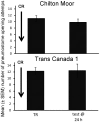How stress alters memory in 'smart' snails
- PMID: 22384220
- PMCID: PMC3286460
- DOI: 10.1371/journal.pone.0032334
How stress alters memory in 'smart' snails
Abstract
Cognitive ability varies within species, but whether this variation alters the manner in which memory formation is affected by environmental stress is unclear. The great pond snail, Lymnaea stagnalis, is commonly used as model species in studies of learning and memory. The majority of those studies used a single laboratory strain (i.e. the Dutch strain) originating from a wild population in the Netherlands. However, our recent work has identified natural populations that demonstrate significantly enhanced long-term memory (LTM) formation relative to the Dutch strain following operant conditioning of aerial respiratory behaviour. Here we assess how two populations with enhanced memory formation (i.e. 'smart' snails), one from Canada (Trans Canada 1: TC1) and one from the U.K. (Chilton Moor: CM) respond to ecologically relevant stressors. In control conditions the Dutch strain forms memory lasting 1-3 h following a single 0.5 h training session in our standard calcium pond water (80 mg/l [Ca(2+)]), whereas the TC1 and CM populations formed LTM lasting 5+ days following this training regime. Exposure to low environmental calcium pond water (20 mg/l [Ca(2+)]), which blocks LTM in the Dutch strain, reduced LTM retention to 24 h in the TC1 and CM populations. Crowding (20 snails in 100 ml) immediately prior to training blocks LTM in the Dutch strain, and also did so in TC1 and CM populations. Therefore, snails with enhanced cognitive ability respond to these ecologically relevant stressors in a similar manner to the Dutch strain, but are more robust at forming LTM in a low calcium environment. Despite the two populations (CM and TC1) originating from different continents, LTM formation was indistinguishable in both control and stressed conditions. This indicates that the underlying mechanisms controlling cognitive differences among populations may be highly conserved in L. stagnalis.
Conflict of interest statement
Figures




Similar articles
-
Two Strains of Lymnaea stagnalis and the Progeny from Their Mating Display Differential Memory-Forming Ability on Associative Learning Tasks.Front Behav Neurosci. 2017 Sep 11;11:161. doi: 10.3389/fnbeh.2017.00161. eCollection 2017. Front Behav Neurosci. 2017. PMID: 28955210 Free PMC article.
-
Strain-specific effects of crowding on long-term memory formation in Lymnaea.Comp Biochem Physiol A Mol Integr Physiol. 2018 Aug;222:43-51. doi: 10.1016/j.cbpa.2018.04.010. Epub 2018 Apr 23. Comp Biochem Physiol A Mol Integr Physiol. 2018. PMID: 29694925
-
Strain-specific differences of the effects of stress on memory in Lymnaea.J Exp Biol. 2017 Mar 1;220(Pt 5):891-899. doi: 10.1242/jeb.149161. J Exp Biol. 2017. PMID: 28250177
-
Environmentally relevant stressors alter memory formation in the pond snail Lymnaea.J Exp Biol. 2014 Jan 1;217(Pt 1):76-83. doi: 10.1242/jeb.089441. J Exp Biol. 2014. PMID: 24353206 Review.
-
A molluscan model system in the search for the engram.J Physiol Paris. 2003 Jan;97(1):69-76. doi: 10.1016/j.jphysparis.2003.10.008. J Physiol Paris. 2003. PMID: 14706692 Review.
Cited by
-
The unlimited potential of the great pond snail, Lymnaea stagnalis.Elife. 2020 Jun 16;9:e56962. doi: 10.7554/eLife.56962. Elife. 2020. PMID: 32539932 Free PMC article.
-
Aspirin reverts lipopolysaccharide-induced learning and memory impairment: first evidence from an invertebrate model system.Naunyn Schmiedebergs Arch Pharmacol. 2022 Dec;395(12):1573-1585. doi: 10.1007/s00210-022-02286-4. Epub 2022 Sep 14. Naunyn Schmiedebergs Arch Pharmacol. 2022. PMID: 36100758
-
Comparison of brain monoamine content in three populations of Lymnaea that correlates with taste-aversive learning ability.Biophys Physicobiol. 2018 May 16;15:129-135. doi: 10.2142/biophysico.15.0_129. eCollection 2018. Biophys Physicobiol. 2018. PMID: 29955564 Free PMC article.
-
Combining stressors that individually impede long-term memory blocks all memory processes.PLoS One. 2013 Nov 6;8(11):e79561. doi: 10.1371/journal.pone.0079561. eCollection 2013. PLoS One. 2013. PMID: 24223180 Free PMC article.
-
What can we teach Lymnaea and what can Lymnaea teach us?Biol Rev Camb Philos Soc. 2021 Aug;96(4):1590-1602. doi: 10.1111/brv.12716. Epub 2021 Apr 6. Biol Rev Camb Philos Soc. 2021. PMID: 33821539 Free PMC article. Review.
References
-
- Dalesman S, Rundle SD, Coleman RA, Cotton PA. Cue association and antipredator behaviour in a pulmonate snail, Lymnaea stagnalis. Animal Behaviour. 2006;71:789–797.
-
- Ferrari MCO, Capitania-Kwok T, Chivers DP. The role of learning in the acquisition of threat-sensitive responses to predator odours. Behavioral Ecology and Sociobiology. 2006;60:522–527.
-
- Healy SD, Bacon IE, Haggis O, Harris AP, Kelley LA. Explanations for variation in cognitive ability: Behavioural ecology meets comparative cognition. Behavioural Processes. 2009;80:288–294. - PubMed
-
- Munoz A, Bonal R. Seed choice by rodents: learning or inheritance? Behavioral Ecology and Sociobiology. 2008;62:913–922.
-
- Skow CD, Jakob EM. Jumping spiders attend to context during learned avoidance of aposematic prey. Behavioral Ecology. 2006;17:34–40.
Publication types
MeSH terms
Substances
LinkOut - more resources
Full Text Sources
Medical
Research Materials
Miscellaneous

